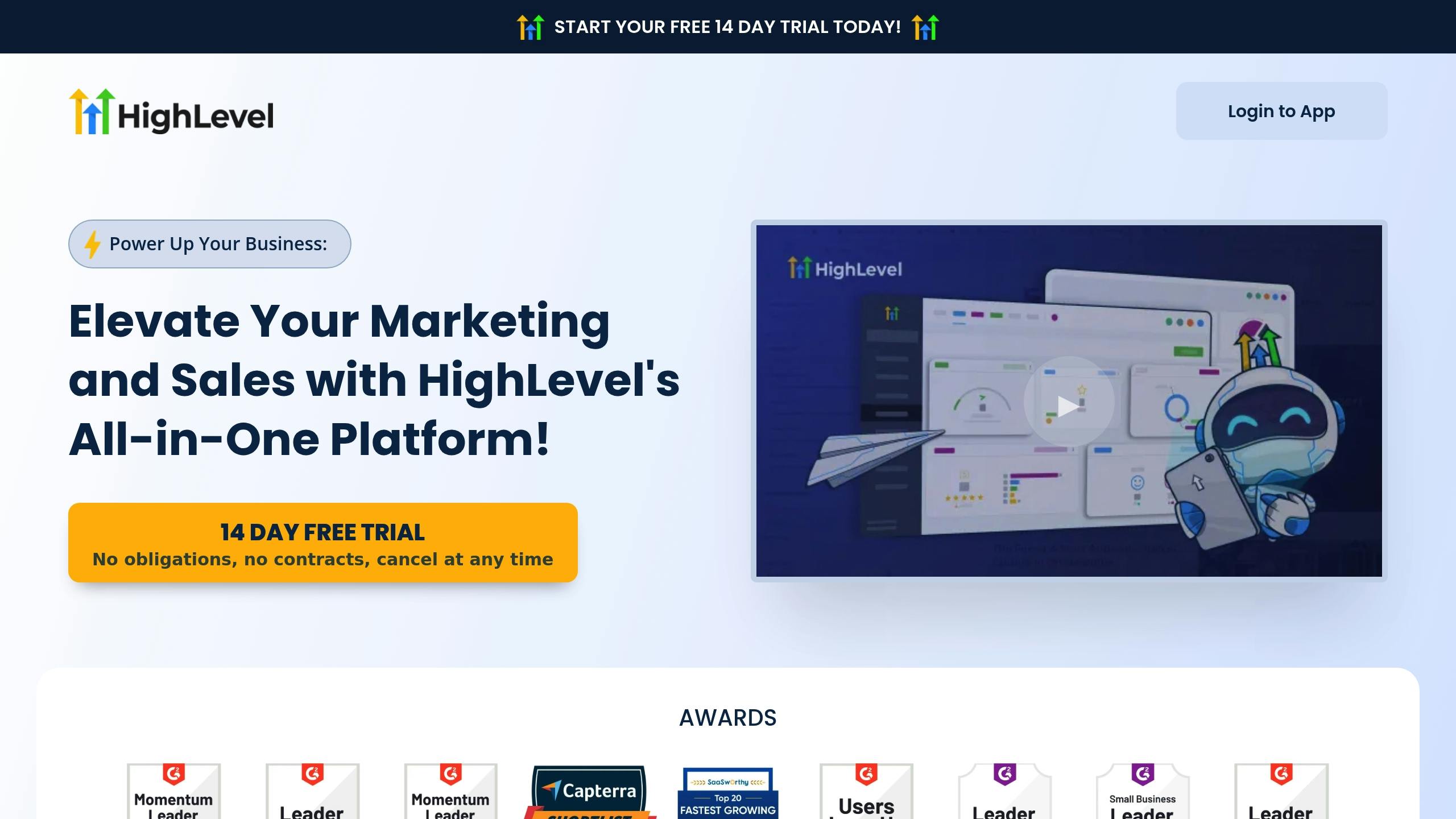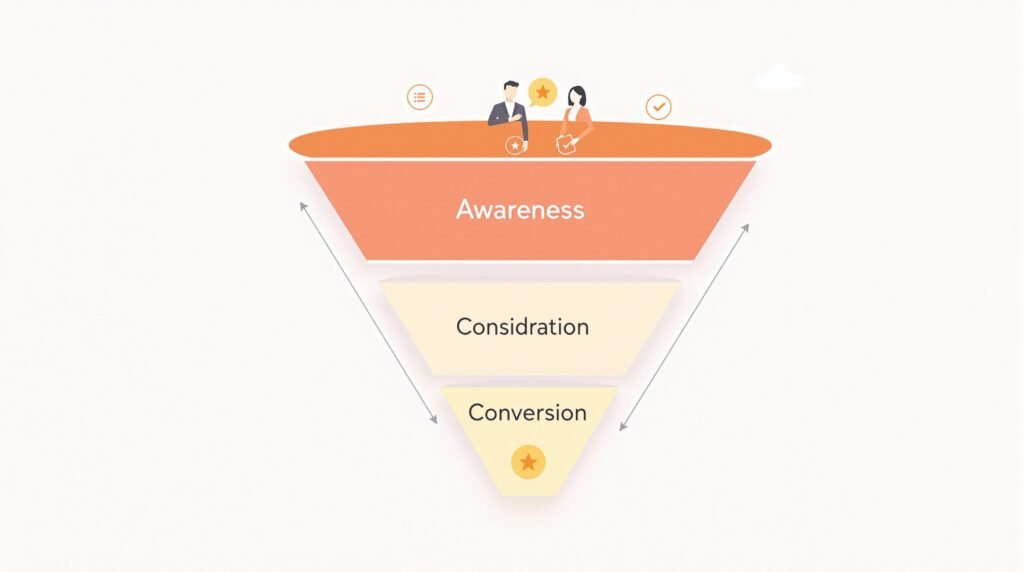Sales funnels are essential for converting leads into customers, but many businesses make avoidable mistakes that hurt their results. Here are the key takeaways to improve your sales funnels effectively:
- Confusing Offers: Make your offer clear, solve a specific problem, and reduce risks with guarantees or social proof.
- Too Many Steps: Keep your funnel between 3–5 stages to minimize drop-offs.
- Poor Mobile Design: Ensure your funnel is mobile-friendly with responsive designs, fast load times, and simple navigation.
- Bad Lead Forms: Use fewer fields, action-driven CTAs, and trust elements to boost conversions.
- Weak Lead Nurturing: Personalize follow-ups, respond quickly, and segment leads to keep them engaged.
- Lack of Testing and Data: Track performance metrics, A/B test key elements, and gather customer feedback to refine your funnel.
Tools like GoHighLevel can help streamline your process with features like drag-and-drop builders, automated follow-ups, and real-time analytics. By avoiding these mistakes and leveraging the right tools, you can create a more effective sales funnel that drives conversions and grows your business.
3 Critical Sales Funnel Mistakes You’re Making Right Now
5 Design Mistakes That Hurt Sales Funnels
A poorly designed sales funnel can tank your conversion rates and drain your marketing budget. Let’s break down some common design mistakes and how to fix them with GoHighLevel’s tools.
Confusing or Weak Offers
Focusing too much on tactics and ignoring the strength of your offer is a common pitfall. As Rand Fishkin puts it, “The best way to sell something is not to sell anything. Instead, earn the awareness, respect, and trust of those who might buy” [2].
For an offer to resonate, it needs:
- A clear solution to the customer’s problem
- Benefits that directly answer, “What’s in it for me?”
- Risk reduction through guarantees or social proof
Take Anderson Hay’s “Andy” product line as an example. They successfully targeted guinea pig owners on Facebook by offering quality pellets (the solution) with a simple pitch: “FREE, just pay to ship” [1]. This straightforward approach outperformed their earlier, overly complex messaging.
Too Many Steps in the Funnel
Studies show that keeping your sales funnel between 3-5 stages is optimal [3]. Funnels with more than six steps often lead to higher abandonment rates due to added friction [3].
To simplify your funnel:
- Map out only the essential actions needed for a purchase
- Set clear goals for each stage
- Streamline transitions between stages
- Eliminate unnecessary fields or pages
Simplifying your funnel keeps users engaged and reduces drop-offs.
Poor Mobile Design
With over 80% of web traffic coming from smartphones [4], mobile-first design isn’t optional – it’s essential. Once your offers and steps are streamlined, ensuring mobile usability becomes a top priority. For example, Brex’s Q3 2023 mobile optimization efforts, which included responsive designs and a smoother checkout process, boosted booked demos by 40%. Similarly, Gorgias achieved a 55% increase in qualified deals by optimizing their mobile sales funnel with responsive landing pages and tailored messaging [4].
For effective mobile optimization, focus on:
- Responsive designs that work across all devices
- Loading times under 3 seconds
- Buttons and forms that are easy to use on touchscreens
- A simplified, quick checkout process
- Readable text without requiring zoom
GoHighLevel’s mobile-ready templates take care of these essentials, and its mobile preview feature lets you fine-tune your funnel’s mobile experience before going live.
Lead Generation Problems and Solutions
Struggling with poor conversion rates? Your lead capture forms might be the culprit. Let’s dive into common issues and how GoHighLevel’s tools can help you fix them.
Basic Form Templates Don’t Convert
Generic forms often fail to engage users. In fact, studies show that reducing form fields to four or fewer can boost conversions by up to 160% [5]. To make your forms more appealing, focus on aligning them with your audience’s preferences.
Here’s how to improve your forms:
- Use action-driven CTAs like “Get My Free Guide” instead of bland options like “Submit.”
- Add trust elements such as security badges or testimonials near form fields.
- Use smart CAPTCHA to minimize visitor frustration by verifying users only once.
- Implement conditional logic to tailor form fields based on previous responses.
For instance, Bonaventure Realty replaced a generic contact form with a home valuation widget featuring address autocomplete and a streamlined multi-step design. This change significantly improved lead quality [6].
Forms That Ask Too Many Questions
Overloading your forms with too many fields can drive prospects away. Keeping it simple works wonders. For example, Obvi’s marketing team used just two fields – email and phone number – for a weekly giveaway campaign, leading to higher signup rates [7].
For B2B lead generation, stick to collecting only the essentials:
- Full name
- Business email
- Job title
You can gather additional details later using progressive profiling during the nurturing phase. This approach respects your prospect’s time while still collecting useful information.
Ineffective Lead Magnets
Once your forms are optimized, focus on offering a lead magnet that directly addresses your audience’s needs. A great example is Hip2Keto‘s ebook on keto myths, which was promoted via a simple two-field popup, resulting in a surge of signups [6].
Examples of high-performing lead magnets include:
- Forrester: A free report with industry forecasts on tech budgets.
- PestControl: Quick, free quotes in just three steps.
- Demio: On-demand webinars with clear learning goals.
“Optimizing your forms to reduce ‘form friction’ should be given just as much attention as the other elements on your offer landing page.” – Allison Woodbury, Director of Content Operations, Conveyor Marketing Group [5]
GoHighLevel’s form builder makes creating optimized forms easy, even without coding skills. Plus, its seamless integration ensures that every lead flows directly into your nurturing sequences, making follow-ups effortless.
sbb-itb-1c6633a
Lead Nurturing Errors to Fix
Even the strongest sales funnels can falter without proper lead nurturing. Adobe’s research shows that businesses excelling in lead nurturing see 50% more sales-ready leads at 33% lower costs [9].
Generic Follow-up Messages
Using generic follow-ups can hurt your conversions. Personalized messages, on the other hand, increase open rates by 29% and click-through rates by 41% [10]. Tools powered by AI can automatically adjust message content based on user behavior, with personalized recommendations increasing revenue by 26% [10].
GoHighLevel’s dynamic merge tags make personalization easier, while its unified inbox helps you manage outreach across SMS, email, Facebook Messenger, and Instagram DMs. This ensures consistent messaging while connecting with leads on their preferred platforms. Plus, automated tools help you respond promptly – a crucial factor in lead nurturing.
Slow Response Times
Did you know that following up within an hour makes leads seven times more likely to convert? GoHighLevel can help you achieve 63% faster response times, leading to 47% higher conversion rates and 50% more lead generation [8][11].
You can set up automated sequences for actions like:
- Form submissions
- Cart abandonment
- Content downloads
- Social media interactions
This ensures you never miss an opportunity to engage with potential customers.
Missing Lead Segments
Personalized messages and quick responses are important, but segmentation is just as critical. Treating all leads the same frustrates 76% of consumers [10]. GoHighLevel’s tagging system allows you to segment your audience precisely.
Here are some ways to tailor your messaging:
- Industry vertical
- Purchase history
- Engagement level
- Geographic location
For example, a real estate agency using GoHighLevel’s pre-built segments saw better engagement by targeting specific groups like:
- Leads who interacted with their last five email campaigns
- Contacts active within the last 7, 30, or 60 days [12]
On average, it takes about ten touches to convert a lead into a sale [8]. With GoHighLevel’s automation and segmentation tools, you can ensure these interactions stay relevant and personalized, avoiding the pitfalls of generic outreach.
Measurement and Testing Oversights
Making decisions based on data is key to improving funnels, but many miss critical tracking steps. GoHighLevel’s Analytics Dashboard offers detailed reports on conversions, leads, and other key metrics, giving you a clearer picture of your funnel’s performance.
Missing Performance Data
Focusing solely on page views often means missing crucial conversion metrics. Here are some key areas to monitor:
| Metric Category | Key Indicators | Why It Matters |
|---|---|---|
| Entry Points | Page views, bounce rate, traffic sources | Understand where leads are entering your funnel. |
| Engagement | Time on page, scroll depth, click patterns | Learn how visitors are interacting with your content. |
| Conversion | Opt-in rate, sales conversion, abandonment | Gauge how well your funnel is converting. |
| Revenue | Average order value, customer lifetime value | Measure the financial success of your funnel. |
GoHighLevel’s Analytics Dashboard can help you uncover patterns, like differences in mobile vs. desktop performance, so you can make timely improvements.
Skipping A/B Tests
A/B testing is essential for refining your funnel. GoHighLevel makes it easy to test and tweak elements like:
- Headlines and CTAs: Experiment with different wording or designs to see what resonates most.
- Form Fields: Simplify forms to improve the user experience and increase conversions.
- Page Layout: Small changes, like moving an opt-in form to a more visible spot, can boost engagement and submissions.
Not Using Customer Input
Customer feedback is a goldmine for improving your funnel. With GoHighLevel’s survey tools, you can collect valuable insights through:
- Post-purchase surveys: Ask buyers about their experience right after they convert.
- Exit intent polls: Find out why visitors leave without taking action.
- Customer satisfaction tracking: Use metrics like NPS scores to monitor and refine your approach.
Conclusion: Building Better Sales Funnels
Quick Fixes for Common Funnel Issues
Creating effective sales funnels requires attention to detail and the right tools. Start by defining your target audience based on their specific needs and goals. Then, simplify the funnel process to reduce any obstacles that might cause potential leads to drop off.
Here are some practical adjustments you can make:
- Simplify forms to collect only the most important information
- Automate follow-ups to ensure immediate engagement
- Optimize for mobile with responsive and fast-loading designs
- Clearly communicate your value by focusing on direct benefits
These steps create a solid foundation for leveraging GoHighLevel’s advanced tools.
Using GoHighLevel Tools Effectively

Once you’ve addressed these common issues, GoHighLevel provides the tools to refine and enhance your funnel. Its drag-and-drop builder makes it easy to design and test different funnel setups, even if you’re not a tech expert. For instance, a consulting firm used GoHighLevel’s automation features to improve lead generation, resulting in better customer acquisition rates, higher-quality leads, and faster follow-up responses.
Some standout features of GoHighLevel include:
- Multi-channel Communication: Combine SMS, email, and voice messaging to keep leads engaged [13]
- Automated Follow-ups: Set up responses triggered by user behavior to maintain momentum [13]
- Analytics Dashboard: Monitor conversion rates and refine your strategy with data-driven insights [13]
- Payment Integration: Use Stripe to simplify transactions directly within your funnel [13]


